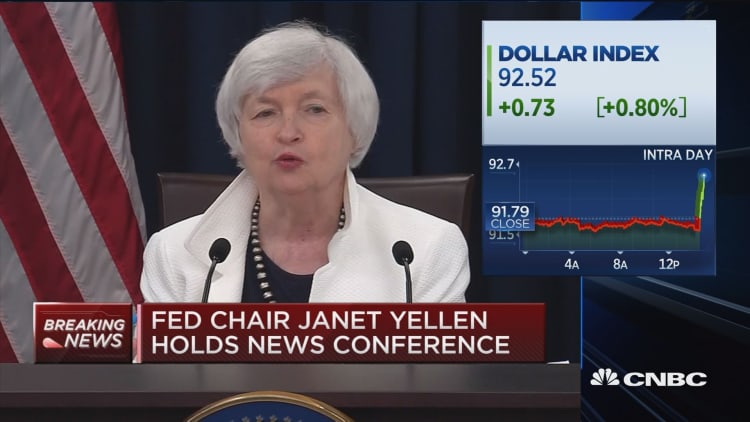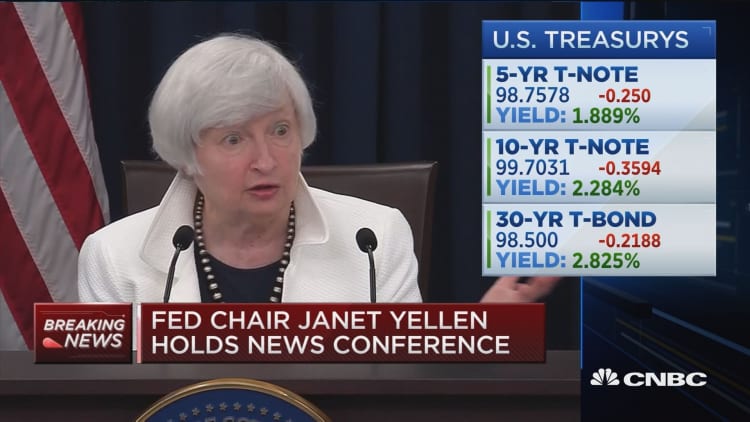
The Federal Reserve took the first tentative steps Wednesday to unwind its history-making economic stimulus.
As markets expected, the U.S. central bank announced it will begin to roll off its $4.5 trillion balance sheet in October. Most of those assets consist of the Treasurys and mortgage-backed securities it acquired under a program known as quantitative easing.
At the same time, the Fed did not raise its benchmark interest rate from its current 1 percent to 1.25 percent target, but indicated that one more hike is likely this year. Officials also projected one fewer rate hike than initially forecast between now and 2019.
As the forecast stands with this week's revisions, there would be three increases in 2018 and two in 2019.
Stocks retreated slightly after the announcement.
The balance sheet reduction program merited just a brief mention near the end of the statement released after the two-day meeting. The policymaking Federal Open Market Committee stated only that the "balance sheet normalization program" as outlined in June will commence next month.

"The market would have liked to see a little more detail on some of this stuff," said JJ Kinahan, chief market strategist at TD Ameritrade. "Although they've been very transparent, they do have a tendency to hold information. This is one more time we see that situation."
The Fed for the first time did provide a formal timetable for how the operation will take place. Instead of reinvesting all the proceeds of its massive bond portfolio, the Fed will allow $10 billion to roll off at first, increasing quarterly in $10 billion increments until the total hits $50 billion starting in October 2018.
The moves to hold the line on interest rates and reduce the balance sheet gained unanimous committee approval.
The balance sheet grew as the Fed began QE in late 2008, during the worst of the financial crisis and the Great Recession. The intent of the program at first was to keep mortgage rates low, but grew to a general attempt to lower short-term rates and provide liquidity to the economy. Stock market prices soared during the three QE stages, though economic growth otherwise was comparatively lackluster and coincided with the slowest recovery since the Great Depression.
While market participants widely expected the lack of an interest rate hike and the balance sheet roll-off, the details of where the Fed stood were considered a wild card.
In their quarterly economic projections, Federal Open Market Committee members now forecast economic growth to run a bit stronger than before. The committee's expectations back in June were for a 2.1 percent GDP gain this year, but that was pushed to 2.2 percent in the latest projections. The long-run outlook for GDP remained at 1.8 percent.
At the same time, the Fed reduced its outlook for inflation, cutting its expectation from 1.7 percent this year to 1.5 percent, and from 2 percent to 1.9 percent in 2018. In sum, that means the Fed now believes it won't reach its 2 percent target until 2019.
"Market-based measures of inflation compensation remain low," the Fed said in a nod to slow wage growth. "Survey-based measures of longer-term inflation expectations are little changed, on balance."
The lack of inflation likely helped push the Fed to reduce the long-run target for its funds rate. While officials for years have been indicating that the rate would make its way to 3 percent, that forecast was reduced to 2.8 percent — effectively one fewer rate hike than originally indicated.
The forecasts were full of nuance that the market is watching closely.
The "dot plot," which provides the forecast of each member for the funds rate, shifted lower in the latest iteration. Twelve of the 16 FOMC members expect another rate hike this year. However, the forecasts for subsequent years were less aggressive. In fact, the longer-run projection of 2.8 percent is actually one-tenth below the 2.9 percent projection for 2019.
Also see: Fed says hurricanes will have no lasting economic impact
WATCH: Yellen says Fed actions stimulated faster recovery



